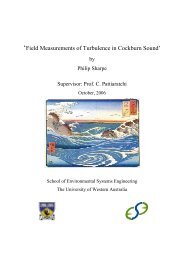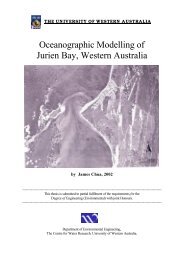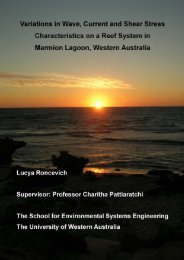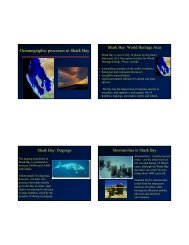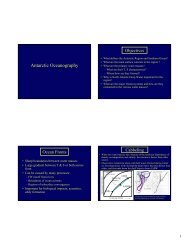Directional Waves in the Nearshore Coastal Region of Perth ...
Directional Waves in the Nearshore Coastal Region of Perth ...
Directional Waves in the Nearshore Coastal Region of Perth ...
You also want an ePaper? Increase the reach of your titles
YUMPU automatically turns print PDFs into web optimized ePapers that Google loves.
<strong>Directional</strong> waves <strong>in</strong> <strong>the</strong> nearshore coastal region <strong>of</strong> <strong>Perth</strong>, Western AustraliaHuey Jean TanThe waves travell<strong>in</strong>g <strong>in</strong>to <strong>the</strong> shallower waters <strong>of</strong> <strong>the</strong> <strong>Perth</strong> metropolitan area (Figure 2.7) aremodified by a number <strong>of</strong> processes, <strong>in</strong>clud<strong>in</strong>g refraction due to changes <strong>in</strong> bathymetry anddiffraction due to exposed reefs and islands. The cont<strong>in</strong>ental shelf along <strong>the</strong> <strong>Perth</strong> coastalregion generally has a mild slope, but <strong>the</strong> actual bathymetry may be ra<strong>the</strong>r complex due to <strong>the</strong>presence <strong>of</strong> submerged limestone ridges (Massel<strong>in</strong>k & Pattiaratchi 2001). The <strong>of</strong>fshore ridges,shallow reef cha<strong>in</strong>s and <strong>the</strong> islands (Rottnest and Garden Islands) have significant shelter<strong>in</strong>geffects on <strong>the</strong> <strong>in</strong>shore wave field from <strong>the</strong> <strong>of</strong>fshore wave conditions. In areas <strong>of</strong> <strong>the</strong>metropolitan coastal waters, a northwesterly w<strong>in</strong>d will generate higher seas than asouthwesterly <strong>of</strong> similar strength because <strong>of</strong> <strong>the</strong> shelter<strong>in</strong>g effect <strong>of</strong> <strong>the</strong> islands <strong>in</strong> <strong>the</strong>southwest direction (BOM 1993).2.4.2 ClimateThe ‘w<strong>in</strong>ter-wet south-west’ <strong>of</strong> Western Australia experiences a Mediterranean-type climatewhich is characterised by hot, dry summers and cool, wet w<strong>in</strong>ters (Gentilli 1972). The major<strong>in</strong>fluence on <strong>the</strong> wea<strong>the</strong>r pattern along <strong>the</strong> south-west coast is <strong>the</strong> position <strong>of</strong> <strong>the</strong> ‘subtropicalridge axis’, which is a belt <strong>of</strong> semi-permanent anticyclonic high pressure systems encircl<strong>in</strong>g<strong>the</strong> sou<strong>the</strong>rn hemisphere between latitudes <strong>of</strong> 25 and 40 degrees south (BOM 1993).Accord<strong>in</strong>g to L<strong>in</strong>acre (1977), <strong>Perth</strong> is Australia’s w<strong>in</strong>diest city, be<strong>in</strong>g exposed to westerlygales <strong>in</strong> w<strong>in</strong>ter and to strong sea breezes <strong>in</strong> summer. The average annual w<strong>in</strong>d speed for <strong>Perth</strong>is 4.3 ms -1 , which is approximately 30% above those <strong>of</strong> o<strong>the</strong>r capitals. <strong>Perth</strong> also experiencesa maximum gust <strong>of</strong> 43ms -1 , far exceed<strong>in</strong>g those <strong>of</strong> most o<strong>the</strong>r capital cities <strong>of</strong> Australia(L<strong>in</strong>acre 1977). There are dist<strong>in</strong>ct variations <strong>in</strong> both <strong>the</strong> seasonal and diurnal w<strong>in</strong>d patterns.The summer w<strong>in</strong>d pattern is characterised by <strong>the</strong> daily sea breeze cycle, and <strong>the</strong> w<strong>in</strong>terwea<strong>the</strong>r is dom<strong>in</strong>ated by <strong>the</strong> passage <strong>of</strong> low pressure systems cross<strong>in</strong>g <strong>the</strong> south-westernregion <strong>of</strong> Australia every 7 to 10 days.Subtropical Ridge Axis and <strong>the</strong> Anticyclonic High Pressure SystemDur<strong>in</strong>g summer, <strong>the</strong> subtropical belt <strong>of</strong> high pressure is over most <strong>of</strong> <strong>the</strong> south-west region,reach<strong>in</strong>g near 40 o S and prevent<strong>in</strong>g most cold fronts from approach<strong>in</strong>g <strong>the</strong> south coast withany strength (BOM 1993, Gentilli 1972). Dur<strong>in</strong>g w<strong>in</strong>ter, <strong>the</strong> belt is displaced to <strong>the</strong> north ataround 25 o S to 30 o S, allow<strong>in</strong>g cold fronts and strong westerly w<strong>in</strong>ds to frequently penetrate<strong>the</strong> sou<strong>the</strong>rn half <strong>of</strong> WA <strong>in</strong> some strength (BOM 1993).18 Literature Review



